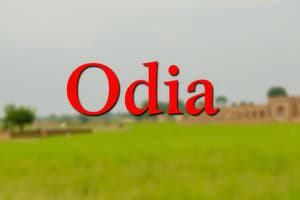Podcast
Questions and Answers
What language family does Odia belong to?
What language family does Odia belong to?
Odia belongs to the Indo-Aryan branch of the Indo-European family.
How many speakers does the Odia language have approximately?
How many speakers does the Odia language have approximately?
Odia has approximately 40 million speakers.
What unique feature does the Odia phonetics include?
What unique feature does the Odia phonetics include?
Odia phonetics include 11 vowels and 33 consonants with unique sounds.
What is the basic word order of Odia grammar?
What is the basic word order of Odia grammar?
Can you name a prominent traditional literature author in Odia?
Can you name a prominent traditional literature author in Odia?
What role does the Odia language play in local festivals?
What role does the Odia language play in local festivals?
What is the official status of the Odia language in India?
What is the official status of the Odia language in India?
What efforts are being made to promote the Odia language digitally?
What efforts are being made to promote the Odia language digitally?
Flashcards are hidden until you start studying
Study Notes
Overview of Odia Language
- Language Family: Indo-Aryan branch of the Indo-European family.
- Speakers: Primarily spoken in the Indian state of Odisha; approximately 40 million speakers.
- Scripts: Written in the Odia script, a Brahmic script similar to Bengali and Assamese.
History
- Origins: Evolved from the ancient language Prakrit; significant literature dates back to the 10th century.
- Influence: Has absorbed words and influences from Sanskrit, Persian, Arabic, and English.
Phonetics and Grammar
-
Phonetics:
- Vowels: 11 vowels; includes short, long, and nasalized forms.
- Consonants: 33 consonants; includes unique sounds not found in many other Indian languages.
-
Grammar:
- Word Order: Subject-Object-Verb (SOV).
- Nouns: Gendered (masculine, feminine, neuter).
- Tenses: Three main tenses (past, present, future) with aspectual distinctions.
Vocabulary
- Borrowings: Has absorbed terms from several languages, enhancing its lexicon.
- Distinctiveness: Contains many unique words and expressions, emphasizing local culture and traditions.
Literature
- Traditional Literature: Rich in poetry, prose, and folk lore; includes works by famous authors like Sarala Das and Upendra Bhanja.
- Modern Literature: Explores contemporary themes; notable modern writers include Fakir Mohan Senapati and Gopinath Mohanty.
Cultural Significance
- Folk Traditions: Integrated with local customs, music, and dance.
- Festival Celebrations: Language plays a crucial role in local festivals and rituals, reinforcing cultural identity.
Current Status
- Official Status: Recognized as one of the 22 scheduled languages of India; used in administration, education, and media.
- Global Presence: Increasing global recognition, with diaspora communities promoting the language abroad.
Resources for Learning
- Material: Textbooks, online courses, language apps, and community classes available for learners.
- Media: Local newspapers, TV channels, and radio stations broadcast in Odia, providing immersion opportunities.
Preservation Efforts
- Institutions: Several organizations and academic institutions promote Odia language and literature.
- Digital Initiatives: Efforts are underway to digitize Odia literature and promote its usage in technology.
Overview of Odia Language
- Odia is an Indo-Aryan language with approximately 40 million speakers, primarily located in the Indian state of Odisha.
- It is written in the Odia script which is a Brahmic script, similar to Bengali and Assamese.
History of Odia
- Odia evolved from Prakrit, an ancient language, and boasts a rich literary tradition dating back to the 10th century.
- Influenced by various languages including Sanskrit, Persian, Arabic, and English.
Phonetics and Grammar of Odia
- Odia has 11 vowels, including short, long, and nasalized forms, and 33 consonants with unique sounds.
- It follows a Subject-Object-Verb (SOV) word order and has gendered nouns (masculine, feminine, neuter).
- Odia has three main tenses (past, present, future) with aspectual distinctions.
Vocabulary of Odia
- Contains unique words and expressions, reflecting local culture and traditions.
- Has absorbed terminology from various languages, enriching its vocabulary.
Literature of Odia
- Abundant in poetry, prose, and folk lore, including works by renowned authors like Sarala Das and Upendra Bhanja.
- Modern Odia literature delves into contemporary issues, with notable modern writers like Fakir Mohan Senapati and Gopinath Mohanty.
Cultural Significance of Odia
- Odia is intricately woven into local customs, music, and dance, strengthening cultural identity.
- It plays a critical role in local festivals and rituals.
Current Status of Odia
- One of the 22 scheduled languages of India used in administration, education, and media.
- Growing global recognition with diaspora communities promoting the language abroad.
Resources for Learning Odia
- Various resources available for learners including textbooks, online courses, language apps, and community classes.
- Odia language is used in local newspapers, TV channels, and radio stations, offering valuable immersion opportunities for learners.
Preservation Efforts for Odia
- Odia language and literature are supported by several organizations and academic institutions.
- Efforts are underway to digitize Odia literature and integrate it into technology.
Studying That Suits You
Use AI to generate personalized quizzes and flashcards to suit your learning preferences.




